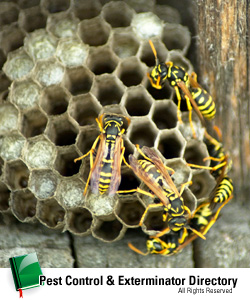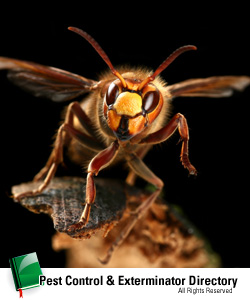All about Hornets
 Hornets are voracious flying stinging insects, which belong to the Vespidae family. They are about 2 inches in length. They can be differentiated from other Vespa genus insects by the width of the vertex. They build nests with a papery material composed of chewed plant foliage and wood.
Hornets are voracious flying stinging insects, which belong to the Vespidae family. They are about 2 inches in length. They can be differentiated from other Vespa genus insects by the width of the vertex. They build nests with a papery material composed of chewed plant foliage and wood.
Hornets are commonly found in North America. They are usually black in color with white markings. However, there are number of hornet species that have extensive yellow markings. Such species are commonly referred to as Yellow Jackets. Yellow jacket hornets are found near humans and their sting can be painful. Those who have sensitivity to their venom may face serious effects.
The adult hornet queen selects some sheltered place like dark hollow tree trunks, rock crevices etc. to lay eggs. She creates a series of 50 cells with the help of a chewed tree bark. The cells are arranged in horizontal pattern and they are named as combs. The combs are closed at the top. She deposits eggs in each cell and they are hatched after 5 to 8 days. The larvae need to go through five stages before attaining the adult stage. The hornet queen feeds the larvae with the diet of insects, which are rich in protein. The larvae spin a silk web over the cell opening. This indicates that the larvae are emerging into the adult stage.
The female hornets are responsible for nest building, caring the brood and foraging. They need to undertake almost all the jobs done by the queen, with the exception of having the ability to lay eggs. Only the queen hornet can lay eggs. The adult male hornets do not take care of nest maintenance, foraging and caring larvae. The male hornets die after mating, but the queen and the workers survive until mid to late autumn. The fertilized queens can live for longer period. The new combs are included, when the size of the colony grows. The nest is then entirely covered, except the entry hole.
European hornets are the most common species and are the largest eusocial wasp. The male and worker hornets are smaller than the queen, which measures 25 to 35 mm. Most of the male hornets have antennae with thirteen segments and the females have twelve segments. The male European hornets have seven visible segments in the abdomen, whereas the females have only six. The female hornets have an ovipositor, which can be changed into a sting.
European hornets are not generally aggressive, except when anyone touches their nest. The stings of these hornets are painful. They can be easily distinguished from other wasps by their deeply indented eyes, shaped like the letter C. They have reddish-orange wings and the petiolate abdomen that is brown with yellow stripes. They do not cause any harmful effects, until they are disturbed. These hornets are not attracted to human food or food waste. European hornets can destroy fruit that is hanging on trees.
Asian giant hornet is the largest hornet in the world. It is also known as Japanese hornet or yak-killing hornet. It has an orange color head and dark brown antennae with orange scapes. The compound eyes are dark brown in color. It has a shield-like plate on the front of the head called clypeus and its posterior side has narrow lobes. The mandible of this hornet is orange in color with black tooth. This hornet feeds on large insects like bees. They attack the hives of honeybees to eat their larvae. A single hornet can kill forty honey bees with its large mandibles.
Asian giant hornet has about 6 mm long stinger and it can inject potent venom that can damage the tissues. The individuals who have allergic reactions to the venom may die, if stung by this hornet.
Eradicating Hornets
 Hornets, like most other wasps are very dangerous to humans as they mobilize the entire nest in order to defend themselves by stinging. Hornets raise an alarm whenever they feel they are in danger and also when they want to prey. It is therefore highly recommended that you get rid of a hornets nest if there is one near your home. One of the most important aspects you need to take care of is to never kill a hornet near the nest. This will cause alarm amongst the rest of the hornets, prompting a potential attack.
Hornets, like most other wasps are very dangerous to humans as they mobilize the entire nest in order to defend themselves by stinging. Hornets raise an alarm whenever they feel they are in danger and also when they want to prey. It is therefore highly recommended that you get rid of a hornets nest if there is one near your home. One of the most important aspects you need to take care of is to never kill a hornet near the nest. This will cause alarm amongst the rest of the hornets, prompting a potential attack.
A hornet’s sting can be an extremely painful experience. Some hornets deliver a typical insect sting while others may be very venomous. Their sting can cause tremendous amount of health complications. There have been plenty of cases where a venomous hornet sting has resulted in death. One of the most common health complications that humans face after a hornet sting is different types of allergic reactions. Here are some tips on avoiding hornet’s sting.
In working towards eradication of a hornet infestation it is very important that you do not disturb the nest in any way. If you happen to come across a hornets nest near your house then make sure that you are never loud when standing near the nest. Stay as far away from the nest as possible. You might notice a hornet who is trying to get back to the nest. Do not disturb them. Allow them to reach the nest.
Many people make the mistake of breaking the hornets nest. Never indulge in such careless acts. By doing so you create panic amongst the hornets and they are sure to attack you aggressively in order to defend themselves. You may end up in a lot of trouble. Hornets are very alert and hence you are also advised not to disturb the air around them. Avoid moving around your hands and legs while you are near the nest.
There are people who ignore the fact that there is a hornet’s nest outside their home. They refuse to do anything about it thinking that if left alone they are harmless. However, this is not the smartest thing to do. It is highly recommended that you get rid of the hornets nest as soon as you can in the most technical manner with the help of professionals.
The first thing to remember as you go about eradicating a hornet’s nest is that the nest has only one opening. This means that if you are planning to use chemicals in order to kill the hornets then it is extremely important that you spray the chemical in that opening. It is highly recommended that spraying of the chemical should be done late in the night. The reason for this is because the hornets are far less active at night as compared to the day time. Another thing is you would find all the hornets in the nest during night as most of them go to search of prey during the day time. Make sure that you do not break any part of the nest while spraying the chemical.
Hornets are extremely protective when it comes to their nest and they become very aggressive if they have to defend it. One of the common behaviors found in hornets is their alarm pheromone. A hornet can alert other hornets in the nest even if it is close to the nest and it has been hurt by any outside factor. The hornet alerts the other hornets to take aggressive action against the instigator of danger. The most recommended method for hornet removal is the hiring of a hornet removal expert, contact your local pest control company for further detail and explanation of services.
The professional would be equipped with all the protective measures and hence it would be much easier for him/her to remove the nest. Many people just get rid of the hornet nest while all the hornets are still active. This is not of any use as the hornets are likely to rebuild their nest in a matter of few days. It is therefore essential that the hornets also are destroyed along with the nest so that you get rid of them on a permanent basis.
Eau Claire Residents Ask: Are Mice Dangerous?
After everyone goes to bed and your Eau Claire home is quiet, do you hear unexplained noises, do you find unexplained chew marks in your kitchen, basement and attic areas? Well, if you do, unless you have ghosts in your home, you probably have mice in your house. And unless you have invited them in yourself, they are most likely uninvited and a guest that you would like to evict as quickly as possible. Along with wanting them out of your home, you are probably worrying and asking yourself, are mice dangerous, what damages are they causing in my home and could they make my family and I ill? The most common type of mouse to enter Eau Claire…


